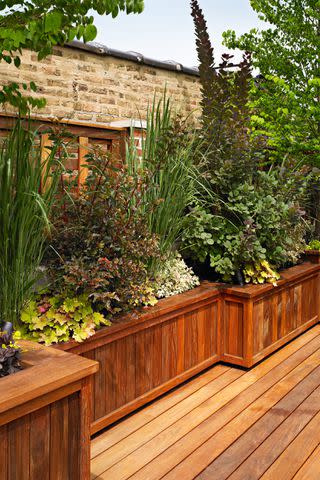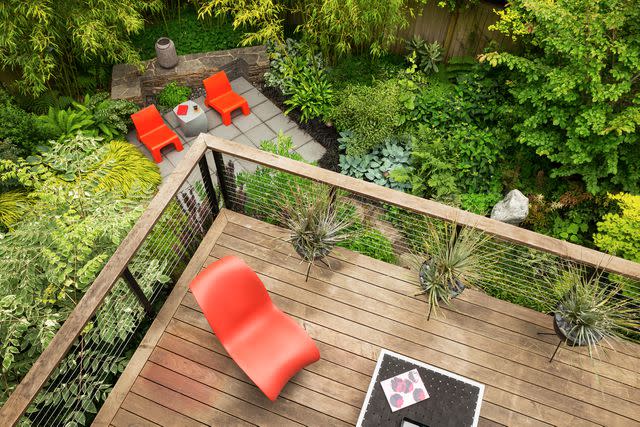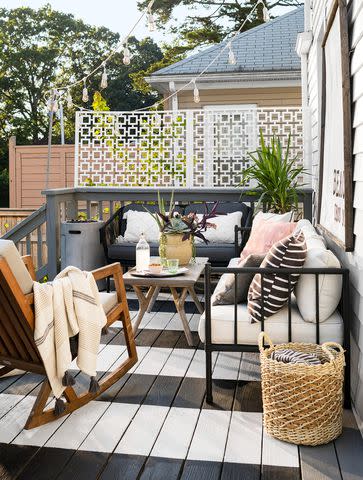A Guide to the Most Common Types of Decks
Create your ideal outdoor living space with this guide to choosing the best deck style and material for your home.

William Wright
Decks are common additions to single-family homes, especially those with large yards, and provide outdoor space to entertain and relax. While there are many types of decks, with structural designs ranging from detached to island to multi-level, each kind adds functional, livable outdoor space.
Decks vary in placement and location, as well as building code requirements, which can influence a deck's size, height, and features. The easiest way to classify decks is by the material used in the construction. The material determines the deck's durability, maintenance requirements, and cost. Various deck materials include natural wood, treated lumber, and composite lumber. Each requires different cleaning and maintenance. Here’s everything you need to know about the types of decks available.
Deck Materials
Decks are frequently categorized based on the types of materials. Below are the most common deck materials.

Nathan Kirkman
1. Wood
Natural wood is durable, easy to install, and feels good under bare feet. The downside is that it requires maintenance, as it can rot, splinter, and host insects. Because wood can warp, you’ll need to keep it clean by sweeping more so than washing. To maintain a wood deck, you’ll need to wash and re-stain it every two to three years to keep it looking its best. Deck wood types include:
Bamboo
Cedar
Ipe
Mahogany
Pressure-treated wood
Redwood
Pressure-treated wood is the most affordable, while high-end varieties like cedar and redwood generally cost more. Pressure-treated wood is lumber injected with preservatives to increase durability or fire retardants to reduce fire risks. Redwood and other hardwoods naturally offer unique colors and textures. Cedar has a classic yellowish look, bamboo is durable and sustainable, and mahogany is resilient. Ipe is the most expensive wood option and is highly resistant to rotting, bugs, wear, splintering, and fire. The ideal wood type will vary based on the weather in your area and how wooded your yard is. Both can affect exposure to the sun, extreme weather, and wood-eating bugs that could ruin a wood deck.
:

John Granen
2. Composite Boards
Composite decking is made from a blend of plastic and wood fibers. It is an alternative to natural wood. For example, polyethylene plastic and wood fiber deck boards contain wood fibers, such as sawdust. Composite is highly resistant to rotting and wear. Thanks to technology, composite boards feature unique and realistic wood grain and patterns to match almost every wood look.
You can also use composite for lattice or railing structures that accompany the deck itself. Composite decking is durable and low maintenance because it doesn't need weather-proofing or paint. Some varieties are also slip- and water-resistant. Unlike natural wood, composite wood rarely warps, splinters, or cracks.

John Granen
3. Polyvinyl Chloride (PVC)
PVC is a versatile material used for pipes, wiring, and even decks. It is 100% synthetic. It does not stain or rot, and it is highly affordable. However, since it's plastic, PVC decking doesn't break down naturally, making it durable with minimal maintenance. Like composite material, PVC comes in a variety of colors. Because it has no organic material, PVC decking is highly resistant to water, mold, mildew, and insect damage.

Ed Gohlich
4. Concrete or Stone
This deck material is the most durable, but it is also the most expensive. Decks made of concrete or stone can last for decades, depending on the installation quality and environmental conditions. The installation cost varies depending on the size of the deck and the exact material used. Stone and concrete decks are an excellent choice for smaller ground-level areas. They can blend well with the home's surroundings and raise property value. However, these materials are heavy, so they are not ideal for raised or elevated structures.

Tria Giovan
5. Aluminum
Aluminum is a popular alternative to wooden decks. This deck material is low maintenance and can last for years without needing replacement. Aluminum is available in various colors and styles to match your preferences. It is also fire-resistant and highly resistant to water damage. As such, it is ideal for areas prone to wildfires, hail storms, strong winds, or heavy rainfall.
:
Deck Styles
You can also classify decks according to the structural design. Below are some of the most common types of decks.

Susan Gilmore
1. Wrap-Around Decks
This large attached deck features a slightly elevated structure that connects two or more sides of the house. Depending on your budget and available space, wrap-around decks can be narrow or spacious. This deck type includes railings, steps, and coverings as desired. The advantage of this deck style is that it offers plenty of usable outdoor space and can easily be accessed from different points around your home. It also extends the living area, when doors to the living areas open to a large deck.

William Wright
2. Multi-Level Decks
This type of deck is an excellent choice if your property isn't perfectly level or consists of hills, slopes, or rocky landscaping. Multi-level decks contain more than one level with steps connecting the different levels. This style allows you to have various sizes of decks to suit different uses, and it allows you to create outdoor living spaces that might not otherwise be available on the ground. Creating living spaces on uneven yards, multi-level decks can incorporate different design styles, including detached and attached.

3. Attached Decks
Typically square, rectangle, L-shape, or U-shape, attached decks are built directly off your home. They may extend an existing room, like a kitchen or dining room. The main advantage of this design is that the deck borrows stability from the house. It also requires less labor and materials and is therefore cost-effective. The main disadvantage to an attached deck is that improper installation or maintenance could create structural damage to your home. Water accumulation or poor weight balance could affect the house. Also, since it is an attached structure, it may require code-approved railings and stairways. These decks usually require permitting and building inspection.

4. Detached Decks
Typically accessed by a path or walkway, detached decks are sometimes called “floating decks.” Often located near a pool or gazebo, these decks are not attached to the house. Constructing a detached deck can be completed by home DIYers. It is the easiest type of deck to build and is often cheaper than attached decks. The downside of this type of deck is that it requires periodic maintenance and is more prone to moisture damage than elevated decks.
Additional styles of decks include rooftop, side yard, garage, swimming pool, entryway, and detailed-use decks.
Factors to Consider When Choosing a Deck Type
Function: Knowing the intended use will help you select a decking material and style to achieve your goal.
Location of the deck: Will the deck be exposed to direct sunlight or regular rainwater? What is the local climate? The location of your deck will determine the best material to use.
Structural design: Do you prefer an attached or detached deck? Is the goal for the deck to extend your living space or just add value to your property? The design you choose will also determine the budget and deck material.
Material: From natural wood to composite to aluminum, the list of deck materials is long. When choosing a material, keep in mind the amount of maintenance required. Natural wood will require more maintenance and regular cleaning, while composite lumber will be more expensive initially but require less maintenance over time.
Building codes: Each city or county can determine building regulations that may affect the size or style of deck you can build. Consult all the regulations before launching any deck project.

